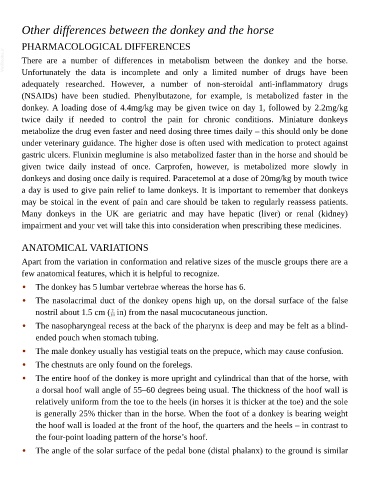Page 1039 - The Veterinary Care of the Horse
P. 1039
Other differences between the donkey and the horse
PHARMACOLOGICAL DIFFERENCES
VetBooks.ir There are a number of differences in metabolism between the donkey and the horse.
Unfortunately the data is incomplete and only a limited number of drugs have been
adequately researched. However, a number of non-steroidal anti-inflammatory drugs
(NSAIDs) have been studied. Phenylbutazone, for example, is metabolized faster in the
donkey. A loading dose of 4.4mg/kg may be given twice on day 1, followed by 2.2mg/kg
twice daily if needed to control the pain for chronic conditions. Miniature donkeys
metabolize the drug even faster and need dosing three times daily – this should only be done
under veterinary guidance. The higher dose is often used with medication to protect against
gastric ulcers. Flunixin meglumine is also metabolized faster than in the horse and should be
given twice daily instead of once. Carprofen, however, is metabolized more slowly in
donkeys and dosing once daily is required. Paracetemol at a dose of 20mg/kg by mouth twice
a day is used to give pain relief to lame donkeys. It is important to remember that donkeys
may be stoical in the event of pain and care should be taken to regularly reassess patients.
Many donkeys in the UK are geriatric and may have hepatic (liver) or renal (kidney)
impairment and your vet will take this into consideration when prescribing these medicines.
ANATOMICAL VARIATIONS
Apart from the variation in conformation and relative sizes of the muscle groups there are a
few anatomical features, which it is helpful to recognize.
• The donkey has 5 lumbar vertebrae whereas the horse has 6.
• The nasolacrimal duct of the donkey opens high up, on the dorsal surface of the false
nostril about 1.5 cm ( in) from the nasal mucocutaneous junction.
• The nasopharyngeal recess at the back of the pharynx is deep and may be felt as a blind-
ended pouch when stomach tubing.
• The male donkey usually has vestigial teats on the prepuce, which may cause confusion.
• The chestnuts are only found on the forelegs.
• The entire hoof of the donkey is more upright and cylindrical than that of the horse, with
a dorsal hoof wall angle of 55–60 degrees being usual. The thickness of the hoof wall is
relatively uniform from the toe to the heels (in horses it is thicker at the toe) and the sole
is generally 25% thicker than in the horse. When the foot of a donkey is bearing weight
the hoof wall is loaded at the front of the hoof, the quarters and the heels – in contrast to
the four-point loading pattern of the horse’s hoof.
• The angle of the solar surface of the pedal bone (distal phalanx) to the ground is similar

